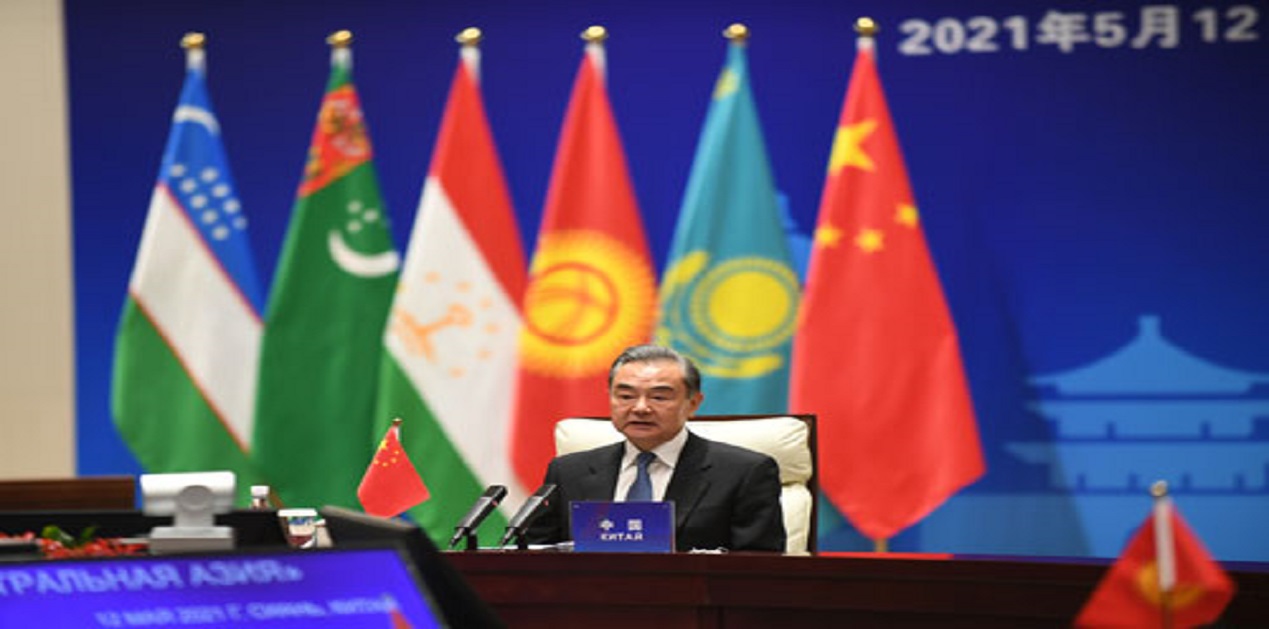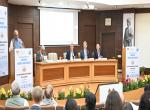Background
China’s relations with its Central Asian neighbours have been complicated. Since the disintegration of the Soviet Union, Central Asia has been crucial for Chinese foreign policy for two reasons. First, the security of its north-western province of Xinjiang, where Uyghurs (a Turkic speaking Muslim ethnic group) having ethno-cultural similarity with the Central Asian population has been facing Chinese repression. Beijing was fearful about Uyghurs getting any support from Central Asia to manoeuvre their anti-Chinese activities. Secondly, Central Asia serves as a powerhouse to China’s increasing energy demand for its burgeoning industrial capacity. Central Asian Republics have huge oil and gas resources, most of which is imported by China by laying multiple pipelines. In 2013, Chinese President Xi Jinping launched its ambitious Silk Road Economic Belt (SREB) Initiative at Nazarbayev University in Nur-Sultan (then Astana), which has further consolidated Beijing’s strategic position in the region. However, with increasing Chinese influence in Central Asia, there is also a rise in anti-Chinese sentiments.1
In the recent past, the emergence of the COVID-19 virus in Wuhan and its rapid spread has resulted in a global pandemic. This has impacted China’s reputation as a trusted partner. China has been held responsible for adopting irresponsible behaviour while dealing with this pandemic. Simultaneously, the aggressive behaviour of Beijing with its neighbours was also recorded. Central Asian Republics (CARs)-Kazakhstan, Kyrgyzstan, Tajikistan, Turkmenistan, and Uzbekistan have also become victims of China's aggressive behaviour. Amidst the pandemic, Beijing’s illegal territorial claims in Tajikistan and Kazakhstan have raised severe concern. China's Belt and Road Projects have also generated troubles and harsh reactions from the local population in Central Asia.2
Subsequently, in July 2020, Beijing launched a new dialogue mechanism with Central Asia. Wang Yi- the Chinese Foreign Minister, had a virtual discussion with the Central Asian Foreign Ministers. The meeting was aimed at discussing avenues of post-pandemic economic cooperation. This initiative is crucial as Beijing already has close and cordial relations with each of CARs. China also engages them on a single platform like the Shanghai Cooperation Organization (SCO). This new mechanism has been seen as another challenge for other stakeholders in the region, such as the US, Russia and India.3
Following this strategic move, Chinese Foreign Minister Wang Yi convened the second meeting of ‘China + Central Asia’ Foreign Ministers on 12th May 2021 in Xi’an, Central China. This meeting was intended to explore new avenues of regional cooperation with their own characteristics and build ‘the China-Central Asia community’ with a shared future. The leaders agreed to eight points covering mainly the Chinese economic and strategic interests, though showcasing them as projects of mutual interests.4
Why is the Second Meeting Important?
The second meeting is significant because of its nature. It took place in China, and that too was attended by the Foreign Ministers of the respective countries amidst the pandemic. This demonstrates the level of confidence that the leadership of CARs has with Beijing.5 It also showcases China’s confidence while dealing with Central Asia without worrying about other actors, mainly Russia. Also, Wang Yi held bilateral discussions with four Central Asian Ministers, including Kyrgyzstan, Tajikistan, Turkmenistan and Uzbekistan.
Major Outcomes
This summit was concluded by adopting an eight-point consensus and three joint statements. The eight-point consensus mainly focused on cooperation in the fight against the pandemic, BRI, mutual trust and cooperation, connectivity, regional security (Afghanistan), upholding multilateralism etc. These points seem to be satisfying more of China’s economic and strategic agendas in Central Asia rather than bringing anything concrete with regard to regional development.
Three Joint Statements were issued at the end of this summit. The first Joint Statement was in response to the pandemic. Through this mechanism, China is also willing to expedite its vaccine diplomacy with the Central Asian nations. Chinese Foreign Minister also promised a new round of vaccine aid in the shape of enhancing joint production of COVID-19 to the group as also providing additional vaccines produced in China. China will also assist in R&D in the production of COVID vaccines.6 Conducting telemedicine cooperation to improve public health capacity is also a plan of this regional mechanism led by Beijing. Last year, amidst the peak of the COVID cases in Central Asia, Chinese aggressive behaviour raised the eyebrows of its Central Asian partners. This mechanism was mainly intended for damage control. The second meeting also appears to be an exercise to restore the Chinese image as a reliable developmental partner.
The second joint statement focused on BRI.7 In the recent past, Chinese activities in Central Asia have garnered sharp reactions from local populations. Chinese workers and projects were attacked in countries like Kyrgyzstan. Therefore, saving President Xi’s ambitious dream remains one of the priorities for Chinese leaders and officials. In this joint statement, deepening Sub-national Cooperation to promote the establishment of the sub-national cooperation mechanism was flagged by the Chinese leader. He also advocated simplifying the cross-border flow of goods and sharing experience on developing and revitalising small and medium-sized cities and rural areas. Intercontinental trade remains one of the major factors for Chinese investment in Central Asia. Therefore, Wang Yi focussed on the smooth operation of Europe-China Freight trains and speedy construction of the transnational railways, including the China- Kyrgyzstan Uzbekistan railway.8 The China- Kyrgyzstan Uzbekistan railway is a strategic project under Chinese BRI, but this project's construction has been delayed due to Kyrgyz apprehensions.9 The status of this project is still mysterious. As the relationship between Uzbekistan and Kyrgyzstan is cordial, the Uzbek President is also keen to make the construction work on this project to progress smoothly.
The third joint statement focussed on Afghanistan. In this meeting, Wang Yi discussed China’s position concerning Afghanistan. This is more significant as the Chinese position is critical with US and NATO troops’ impending exit from the country by September 2021. An unstable Afghanistan is also a threat to Chinese domestic security. There have been reports regarding Chinese military bases in Wakhan Corridor and also in Tajikistan.10 Three of the Central Asian countries- Tajikistan, Uzbekistan and Turkmenistan share a border with Afghanistan. Having similar security concerns, these CARs have been actively participating in the Afghan Peace process. Uzbekistan and Turkmenistan have also built rail links with Afghanistan. Central Asian countries have geophysical, political and trade advantages with Kabul. Therefore, Wang asked Central Asian countries to play a constructive role in this regard. Due to the political insecurity surrounding Afghanistan, the country was not represented at this meeting. However, China’s call for each participating nation to coordinate an approach to secure the country will eventually lead it to join the grouping. 11
Conclusion
This new mechanism will add more value to China’s relations with the Central Asia region. China’s increasing influence in Central Asia will ultimately become a threat to other stakeholders like Russia, the US and India. However, Russia is not in a position to confront China at this point in time. There will an ultimate conflict of interests between the two in the coming future. Since 2015, India’s Central Asia policy has brought some positive results; however, there is still a fissure that needs to be filled soon by expediting connectivity projects such as Chabahar and INSTC. For both these projects, India’s cooperation with Russia is crucial. Having China as a competition, India, Russia, and the US need to give more leverage to the Central Asian republics to not entirely rely on China. They also need to substantiate their multilateral mechanisms with the Central Asian partners to increase their influence and counter China.
Endnotes
- “President Xi Jinping Delivers Important Speech and Proposes to Build a Silk Road Economic Belt with Central Asian Countries”, MFA, Peoples Republic of China, September, 7 2013. https://www.fmprc.gov.cn/mfa_eng/topics_665678/xjpfwzysiesgjtfhshzzfh_665686/t1076334.shtml
- P K Gupta, “second-India-central Asia dialogue: major takeaways”, Article Vivekananda International Foundation, November 5 2020. https://www.vifindia.org/article/2020/november/05/second-india-central-asia-dialogue-major-takeaways
- Ibid.
- SD Pradhan, “China plus Central Asia foreign ministers’ meeting: China’s game plan to push BRI and and enhance its influence in Afghanistan”, Times of India, May 17, 2021. https://timesofindia.indiatimes.com/blogs/ChanakyaCode/china-plus-central-asia-foreign-ministers-meeting-chinas-game-plan-to-push-bri-and-enhance-its-influence-in-afghanistan/
- Cuisinart Grills Review: May 2021, Gadget Review. https://www.gadgetreview.com/cuisinart-grills-review
- endnote 6- Łukasz Kobierski, “China+Central Asia (C+C5) Meeting”, May 17 2021, China monitor, Warsaw Institute. https://warsawinstitute.org/chinacentral-asia-cc5-meeting/
- Wang Yi Talks about Eight-point Consensus and Ten Outcomes of "China+Central Asia" Foreign Ministers' Meeting, MFA, Peoples Republic of China, May 12, 2021 https://www.fmprc.gov.cn/mfa_eng/zxxx_662805/t1875501.shtml
- Chris Devonshire-Ellis, “The China-Central Asia Conference: Analysis” Silk Road Briefing, May 14, 2021 https://www.silkroadbriefing.com/news/2021/05/14/the-china-central-asia-conference-analysis/
- Jalil Saparov and Bakyt Ibraimov, “China-Kyrgyzstan-Uzbekistan railway remains uncertain”, the Third Pole, January 13, 2021 https://www.thethirdpole.net/en/regional-cooperation/china-kyrgyzstan-uzbekistan-railway-remains-uncertain/
- “Chinese Military Base: Is China Building a Military Base in Afghanistan”, The Eurasian Times, February 2, 2018. https://eurasiantimes.com/chinese-military-base-afghanistan/
- Chris Devonshire-Ellis, “The China-Central Asia Conference: Analysis” Silk Road Briefing, May 14, 2021 https://www.silkroadbriefing.com/news/2021/05/14/the-china-central-asia-conference-analysis/
(The paper is the author’s individual scholastic articulation. The author certifies that the article/paper is original in content, unpublished and it has not been submitted for publication/web upload elsewhere, and that the facts and figures quoted are duly referenced, as needed, and are believed to be correct). (The paper does not necessarily represent the organisational stance... More >>
Image Source: https://www.fmprc.gov.cn/mfa_eng/zxxx_662805/W020210513546721506449.jpg











Post new comment